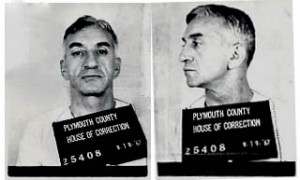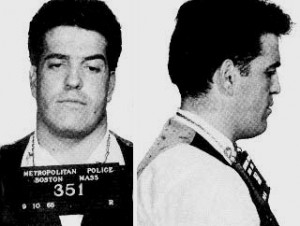The animating idea of The Strangler was to recreate Strangler-era Boston, to bring the lost city to life so convincingly that readers would have the immersive three-dimensional experience of actually being there, walking the streets, brushing shoulders with the people. Period authenticity was important: the original working title of the book was The Year of the Strangler.
Of course reanimating the actual city required that a few prominent Bostonians appear undisguised, or nearly so, including gangsters, cops, and politicians. In the original draft, these characters were accurately named and described. The mob boss Capobianco, for example, was called by his real name, Gennaro Angiulo. The historical Gerry Angiulo ran the Boston mob during my childhood in the 1970s. In 1963 and ’64, when The Strangler takes place, he was just consolidating his power.

On the eve of the book’s publication, I got a call from a lawyer at Random House asking about some of these historical figures, including Angiulo. “Is he still alive?” the lawyer wanted to know. Apparently libel laws are stricter when the subject is living. Angiulo was 87 years old then, but still alive in a federal prison. So his name had to be changed. To further insulate the book from a libel charge, Angiulo had to be mentioned by name in the book so we could plausibly deny that my character Capobianco was an Angiulo stand-in. After all, we could argue, there is Angiulo standing next to Capobianco — how could they be the same person? All this sensitivity about the man’s reputation seemed a little ridiculous to me. How was it possible to libel a murderer and convicted mafioso like Gerry Angiulo? But I did not insist, and shortly before publication the character was rechristened Charlie Capobianco. Still the facts remain: the novel’s description of a “born bookie” who became a mob boss — his physical appearance, his biography, his North End headquarters, his bookmaking operation — all are meticulously faithful to the life of Gerry Angiulo. (The libel issue is moot now. Gerry Angiulo died at the end of August, at age 90. His funeral procession required a flatbed truck to carry the 190 bouquets of flowers.)
Another underworld figure who appeared in the book, lightly disguised, was a vicious hit man named Joseph “The Animal” Barboza. In The Strangler, the Barboza character is called Vincent “The Animal” Gargano, and if you think the character is brutal, I assure you, the original was three times as frightening. Internal FBI reports of the time describe Joe Barboza as “the most vicious criminal in New England,” “a professional assassin responsible for numerous homicides and acknowledged by the professional law enforcement representatives in this area to be the most dangerous individual known.” He was rumored to have killed twenty men. The actual number may have been much higher.

Barboza was a Portuguese-American from New Bedford. He had been a boxer as a young man. While serving time in MCI-Concord he met a lot of gangsters, and when he was released he moved to East Boston to enter the rackets himself.
The story of Joe Barboza’s rise in the Boston underworld of the 1960s is predictably shadowy. He wrote a tell-all book in 1975, with Hank Messick, called Barboza. It is a hair-raising read but hard to trust: the author was an infamous liar. The book is long out of print and hard to find. Used paperbacks go for $200. The Boston Public Library has only a photocopy of the book, which does not circulate.
In any event, what makes Barboza more than just a local thug is what happened to him after the Strangler era. In 1967, Barboza became a cooperating witness for the FBI and later became the first man to enter the federal Witness Protection Program.
His false testimony in a 1968 murder trial would ultimately unravel a story of unimaginable corruption in the FBI’s Boston office, a story in which crooked FBI agents actually protected gangster-informants while they went right on murdering people in the street. Imagine: a select few mobsters were effectively above the law, protected by the federal government. There is a straight line from the feds’ protection of Joe Barboza in the 1960s to its infamous marriage with Whitey Bulger in the 1970s, ’80s and ’90s. It is as if, in Chicago, Al Capone had cut a deal with Eliot Ness for FBI protection. It is the defining story of the Boston crime world.
The whole story is told in a congressional report called “Everything Secret Degenerates.” If the story interests you, I highly recommend it. The prose is dry and lawyerly, and there is a lot of detail, still the story leaps off the page. There are many other, less authoritative versions out there on the web.
Briefly, the story is this. On March 12, 1965, Barboza and a small crew murdered a small-time hood named Teddy Deegan. Six men were indicted for the Deegan murder. At trial, Barboza — by then a protected state witness — testified in detail about how the murder was planned and carried out. On July 31, 1968, after a two month trial, all six defendants were convicted. Four got the death penalty, two life in prison, all on Barboza’s word.
The trouble was, Barboza lied — and the FBI knew it all along. Four of the men he named — Louis Greco, Peter Limone, Henry Tameleo, and Joseph Salvati — had nothing to do with the crime. And one he did not name, Jimmy “The Bear” Flemmi, was actually one of the ringleaders and may well have been the triggerman. The day after the murder, Flemmi admitted to an FBI informant that he was in on it.
Why did the FBI keep silent? To protect a valued informant-witness in Barboza, no doubt. But it is also true that Jimmy The Bear had been an FBI informant for awhile, a fact the feds were eager to cover up. Flemmi was nearly as volatile as Barboza. He had told an FBI informant that he hoped “to become recognized as the No. One ‘hit man’ in this area as a contract killer.” In 1964, as the congressional report dryly puts it, “Flemmi killed an FBI informant by stabbing him fifty times and then, in a surfeit of enthusiasm, shooting him.” The FBI knew Jimmy The Bear was out of control. In September 1965, he shot another man and was charged with ABDW with intent to murder, and the feds dropped him as an informant — not because of the murder but because, according to an internal FBI memo, “any contacts with him might prove to be difficult and embarrassing.”
Of the four innocent men Barboza framed in the Deegan trial, two died in prison after serving almost thirty years, two others were finally released in the 1990s. The legal battle to free those men was one of the threads that ultimately unraveled the FBI’s corrupt alliance with the Boston mob, most notoriously Whitey Bulger.
But that is a story for another day. (In the meantime, if you’d like to browse a rogue’s gallery of plug-uglies and gunsels from Boston’s gangster past, I highly recommend Howie Carr’s web site, Whitey’s World, a cleaned-up version of the old, priceless Whitey Watch site. There’s nothing else quite like it, and I referred to it often during the writing of The Strangler.)
Back to Joe Barboza. The feds shipped “The Animal” off to California, where of course he murdered again and was protected by the FBI again. The Boston mob, which had put out a contract on Barboza the moment he flipped in 1967, finally caught up with him in San Francisco in 1976, where a North End capo named Joe Russo finally put him down.
All that lay in the future in the Strangler days of ’63 and ’64 when Joe Barboza was cruising the city like a shark and Gerry Angiulo was building his bookmaking operation into an empire. The Boston underworld depicted in The Strangler is a brutal place indeed — too bloody for some readers, as I have been told many times. But the truth is, my novel actually understates the reality of gangland Boston in the ’60s, which was simply more violent than ordinary readers are prepared to believe. Fiction, unlike reality, must be credible.